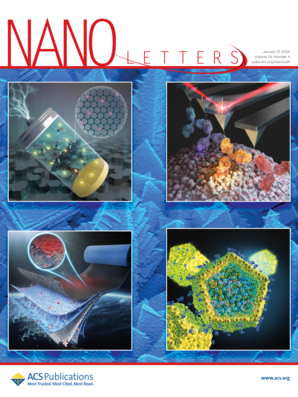Unlocking Ampere-Level Nitrate Electroreduction to Ammonia Via the Built-In Electric Field in Monometallic Catalysts
IF 9.6
1区 材料科学
Q1 CHEMISTRY, MULTIDISCIPLINARY
引用次数: 0
Abstract
Bimetallic/multimetallic catalysts for nitrate reduction reaction (NO3–RR) have been extensively investigated benefiting from their synergistic effects in optimizing various intermediate adsorptions; however, the interphasic synergistic effects in monometallic catalysts are often overlooked. Here we report an interphasic synergy between electron-rich Co(OH)2 and electron-deficient CoO, in which the asymmetric charge distribution in monometallic cobalt-based heterojunction derived from the built-in electric field (BEF) significantly accelerates electron transfer and lowers the energy barriers for NO3–RR. Theoretical calculations reveal that the chemical affinities of Co atoms toward NO3– and NO2– are significantly enhanced and even NO3– adsorption switches to a spontaneous process. Simultaneously, the BEF in monometallic Co-based heterostructures greatly reduces the energy barrier of the rate-determining step (*NO→*NOH) in the NO3–RR. Therefore, the resultant catalyst exhibits ampere-level NO3–RR performance, achieving a record NH3 yield up to 73.9 mg h–1 cm–2 at a low potential of −0.2 V with a Faradaic efficiency (FE) of 95.6%.

利用单金属催化剂内建电场解锁安培级硝酸电还原制氨
硝酸还原反应的双金属/多金属催化剂由于具有协同效应而得到了广泛的研究;然而,单金属催化剂的相间协同效应往往被忽视。本文报道了富电子Co(OH)2和缺电子CoO之间的相间协同作用,其中由内置电场(BEF)产生的单金属钴基异质结中的不对称电荷分布显著加速了电子转移并降低了NO3-RR的能量势垒。理论计算表明,Co原子对NO3 -和NO2 -的化学亲和力显著增强,甚至NO3 -的吸附也转为自发过程。同时,单金属co基异质结构中的BEF大大降低了NO3-RR中速率决定步骤(*NO→*NOH)的能垒。因此,合成的催化剂表现出安培级的NO3-RR性能,在−0.2 V的低电位下,NH3的产率高达73.9 mg h-1 cm-2,法拉第效率(FE)为95.6%。
本文章由计算机程序翻译,如有差异,请以英文原文为准。
求助全文
约1分钟内获得全文
求助全文
来源期刊

Nano Letters
工程技术-材料科学:综合
CiteScore
16.80
自引率
2.80%
发文量
1182
审稿时长
1.4 months
期刊介绍:
Nano Letters serves as a dynamic platform for promptly disseminating original results in fundamental, applied, and emerging research across all facets of nanoscience and nanotechnology. A pivotal criterion for inclusion within Nano Letters is the convergence of at least two different areas or disciplines, ensuring a rich interdisciplinary scope. The journal is dedicated to fostering exploration in diverse areas, including:
- Experimental and theoretical findings on physical, chemical, and biological phenomena at the nanoscale
- Synthesis, characterization, and processing of organic, inorganic, polymer, and hybrid nanomaterials through physical, chemical, and biological methodologies
- Modeling and simulation of synthetic, assembly, and interaction processes
- Realization of integrated nanostructures and nano-engineered devices exhibiting advanced performance
- Applications of nanoscale materials in living and environmental systems
Nano Letters is committed to advancing and showcasing groundbreaking research that intersects various domains, fostering innovation and collaboration in the ever-evolving field of nanoscience and nanotechnology.
 求助内容:
求助内容: 应助结果提醒方式:
应助结果提醒方式:


